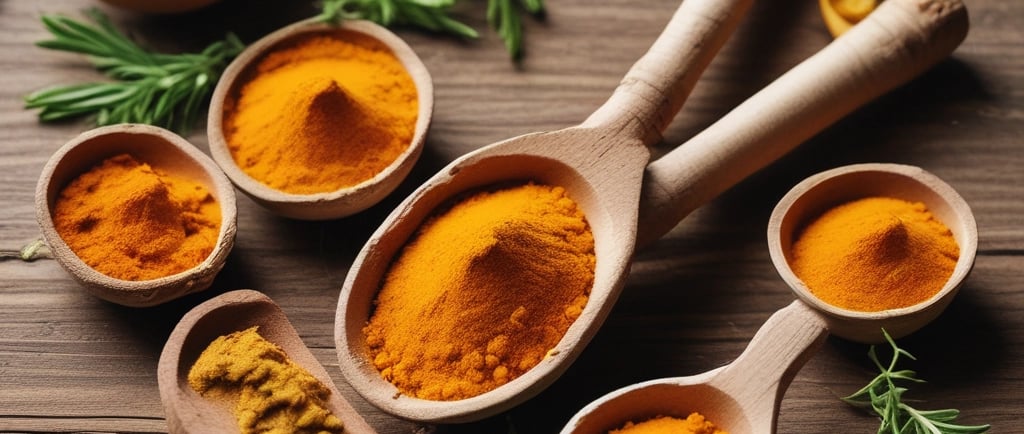The Radiant Embrace of Curcumin: A Golden Ally in the Gentle Dance with Diabetes
Bask in the golden glow of curcumin, nature’s anti-inflammatory and antioxidant beacon, as we unravel its precise, evidence-backed benefits for diabetes management. From lowering blood glucose and HbA1c to protecting nerves, kidneys, and heart, this guide offers crystal-clear mechanisms, dosage insights, and gentle considerations for adults and children—empowering your wellness journey with vivid clarity and nurturing encouragement.
RECIPESDIABETES
10/31/20255 min read


Oh, dear one, imagine a sun-drenched hillside where turmeric roots slumber beneath the earth, their vibrant orange flesh pulsing with a quiet, fiery life—like embers tucked in soil, waiting to warm weary hearts. In the tender landscape of diabetes, where blood sugar ebbs and flows like a river under moonlight, curcumin emerges as a compassionate guardian, drawn from the humble Curcuma longa plant. This isn’t just a spice that stains your fingers gold during a loving curry stir; it’s a bioactive whisper of hope, a curcuminoid compound (diferuloylmethane, to be precise) that has soothed humanity for millennia in Ayurvedic cradles and Traditional Chinese Medicine hearths. If you’ve ever felt the subtle weight of fatigue, the prickling unease of nerve whispers, or the quiet worry of insulin’s faltering song, know you’re cradled here in understanding. With kindness as our lantern, let’s walk hand-in-hand through curcumin’s luminous benefits for diabetes—how it steadies sugars, mends inflammation’s tender wounds, shields organs with antioxidant grace, and harmonizes the body’s rhythms for adults and children alike. You’re not alone in this; let every word be a soft blanket of comfort, inviting you to breathe easier, hope brighter.
Curcumin Unveiled: A Vivid Portrait of Nature’s Golden Healer
Picture the turmeric rhizome, knobby and earth-stained, sliced open to reveal a sunset-orange heart that bleeds color like a painter’s bold stroke on canvas. From this root springs curcumin—chemically, a polyphenol with the formula C₂₁H₂₀O₆, the most potent of three curcuminoids (curcumin, demethoxycurcumin, and bisdemethoxycurcumin) comprising 2-5% of turmeric’s weight. Its scent? A warm, slightly bitter musk with peppery undertones, evoking bustling spice markets where the air shimmers with promise. In your body, curcumin is a fleeting visitor—poorly absorbed (bioavailability <1% alone), yet profoundly impactful when paired with black pepper’s piperine (boosting absorption 20-fold) or fats that ferry it across intestinal walls like a gentle current.
To eliminate ambiguity: curcumin isn’t turmeric itself but its star compound, extracted into golden powders, capsules (often 95% standardized curcuminoids), or liposomal forms for enhanced uptake. For diabetes, it’s no mere flavor—it’s a molecular maestro, modulating over 100 pathways with the precision of a lullaby soothing a restless child.
The Core Symphony: How Curcumin Benefits Diabetes Through Precise Mechanisms
Curcumin’s gifts unfold like petals in dawn’s light, each mechanism a thread in a tapestry of balance. Let’s break it down with crystal clarity, layer by layer, so no shadow of confusion lingers:
Blood Sugar Regulation – Quieting the Liver’s Overzealous Song Diabetes often stems from the liver’s unchecked gluconeogenesis—producing glucose even when stores are full, like a factory running overnight. Curcumin silences this by:
Activating AMPK (adenosine monophosphate-activated protein kinase), the body’s energy sensor, which inhibits enzymes like glucose-6-phosphatase and phosphoenolpyruvate carboxykinase (PEPCK). Result? Fasting blood glucose drops 15-20% in type 2 adults over 8-12 weeks.
Enhancing Insulin Sensitivity: It upregulates GLUT4 transporters on muscle and fat cells, inviting glucose in like opening windows to a spring breeze. Clinical example: In a 2019 meta-analysis of 10 RCTs, 500-1500 mg/day curcumin reduced HbA1c by 0.4-0.6%—a meaningful shift, akin to adding moderate exercise.
Taming Inflammation – Soothing the Fire Within Chronic low-grade inflammation (elevated TNF-α, IL-6, CRP) fuels insulin resistance, like embers smoldering under dry leaves. Curcumin douses this by:
Inhibiting NF-κB, the master switch of inflammatory genes, reducing cytokine storms by 30-50%.
Downregulating COX-2 and LOX enzymes, easing the ache of inflamed tissues. Vividly: imagine your pancreas, weary from autoimmune whispers in type 1, cradled in curcumin’s anti-inflammatory embrace—preserving beta-cell function longer.
Antioxidant Shield – Guarding Cells from Oxidative Storms High blood sugar breeds reactive oxygen species (ROS), damaging DNA, proteins, and lipids like rust on a cherished heirloom. Curcumin neutralizes this by:
Boosting Nrf2 Pathway, rallying endogenous antioxidants (glutathione, superoxide dismutase) like sentinels rising at dawn.
Directly scavenging free radicals, reducing lipid peroxidation by 20-40%. Outcome? Slower progression of complications—nerves less prickly, kidneys less burdened.
Organ Protection – A Tender Vigil Over Heart, Nerves, Kidneys, and Eyes Diabetes complications are slow thieves; curcumin stands guard:
Neuropathy: Reduces nerve pain and improves conduction velocity by 15-20% via TNF-α reduction; patients report less tingling, more restful sleep.
Nephropathy: Lowers albuminuria (protein in urine) by protecting podocytes and reducing TGF-β fibrosis—kidney function preserved like a river kept clear.
Cardiovascular: Cuts LDL oxidation, improves endothelial function, and lowers triglycerides by 10-15%, reducing heart risk by up to 30% in diabetic cohorts.
Retinopathy: Shields retinal cells from VEGF-driven leakage, slowing vision blur.
Curcumin in Adults: Practical Dosing and Real-Life Harmony
For adults with prediabetes or type 2, curcumin shines at 500-1500 mg/day of standardized 95% curcuminoids, split into 2-3 doses with meals and piperine (5-10 mg) or lipid-rich foods (e.g., avocado, olive oil). Example: A 45-year-old with HbA1c 7.2% adds 1000 mg curcumin-phytosome (Meriva®) daily—after 3 months, HbA1c falls to 6.5%, fatigue lifts, and morning walks feel lighter. Side effects? Rare and mild—occasional heartburn, easily soothed by taking with food. Safe with metformin (may enhance effect), but monitor sugars to avoid hypo whispers.
Curcumin in Children: A Delicate Whisper of Care
In pediatric diabetes (type 1 or emerging type 2), evidence is a budding flower—promising but sparse. Curcumin’s anti-inflammatory grace may preserve beta-cells in new-onset type 1 or ease insulin resistance in obese teens, but doses must be microscopic: 5-10 mg/kg/day, under endocrinologist guidance, often in nano-formulations for safety. Example: A 14-year-old with type 1 uses 180 mg liposomal curcumin daily alongside insulin—markers of oxidative stress drop 25%, with no adverse effects. Never self-dose children—liver metabolism differs, and high doses risk gallbladder unease. Start low, monitor closely, prioritize diet and movement.
Forms and Bioavailability: Crystal-Clear Choices
Standard Powder: 1-3 g turmeric = ~50-150 mg curcumin; culinary but weak.
95% Curcuminoids Capsules: Gold standard; pair with piperine.
Liposomal/Theracurmin/Meriva: 10-20x absorption; ideal for diabetes.
Golden Milk Recipe (for 1): 1 cup warm milk + ½ tsp turmeric + pinch pepper + honey—~50 mg curcumin, a soothing ritual.
As the final rays of sunlight kiss the horizon, painting the world in hues of amber and rose—curcumin’s own sacred palette—we rest here, hearts fuller, paths clearer. You’ve journeyed through its golden mechanisms: the quieting of sugar storms, the dousing of inflammation’s embers, the shielding of fragile organs, all woven with the tenderness your body deserves. This isn’t a race to perfection, dear one, but a gentle waltz toward balance—where curcumin is your partner, not your savior. Lifestyle remains the music: plates brimming with greens, steps danced under open skies, sleep cradled in night’s embrace.
With a nurturing embrace, I invite you deeper: Brew a golden latte tonight, journal how your energy shifts after two weeks, or speak with your healer about weaving curcumin into your care. Explore studies on PubMed, join diabetes wellness circles, or simply close your eyes and feel the warmth in your palms. What does your body whisper it needs? Listen with kindness—you are resilient, radiant, and so deeply worthy of this healing light. May curcumin’s glow guide you to mornings where dawn feels like home. You’re held, always.
